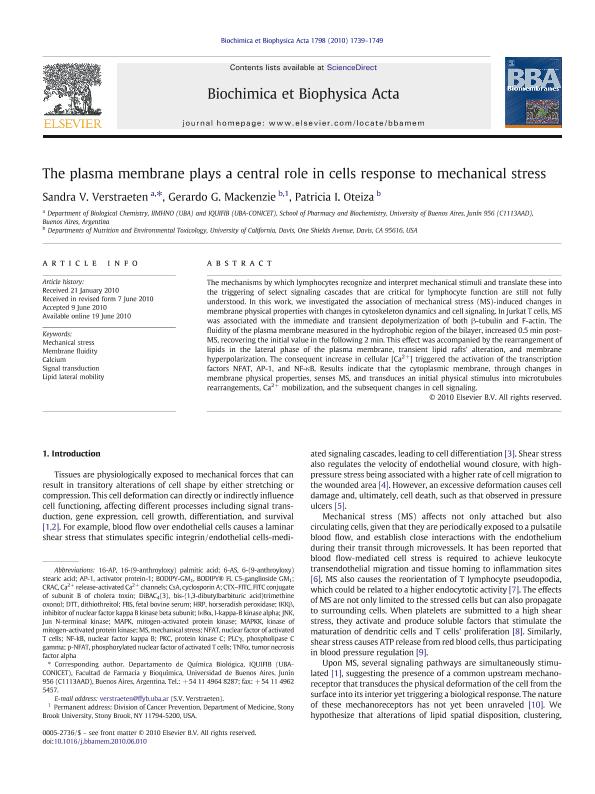Mostrar el registro sencillo del ítem
dc.contributor.author
Verstraeten, Sandra Viviana

dc.contributor.author
Mackenzie, Gerardo G.

dc.contributor.author
Oteiza, Patricia Isabel

dc.date.available
2017-06-14T19:43:25Z
dc.date.issued
2010-09
dc.identifier.citation
Verstraeten, Sandra Viviana; Mackenzie, Gerardo G.; Oteiza, Patricia Isabel; The plasma membrane plays a central role in cells response to mechanical stress; Elsevier Science; Biochimica et Biophysica Acta - Biomembranes; 1798; 9; 9-2010; 1739-1749
dc.identifier.issn
0005-2736
dc.identifier.uri
http://hdl.handle.net/11336/18199
dc.description.abstract
The mechanisms by which lymphocytes recognize and interpret mechanical stimuli and translate these into the triggering of select signaling cascades that are critical for lymphocyte function are still not fully understood. In this work, we investigated the association of mechanical stress (MS)-induced changes in membrane physical properties with changes in cytoskeleton dynamics and cell signaling. In Jurkat T cells, MS was associated with the immediate and transient depolymerization of both β-tubulin and F-actin. The fluidity of the plasma membrane measured in the hydrophobic region of the bilayer, increased 0.5 min post-MS, recovering the initial value in the following 2 min. This effect was accompanied by the rearrangement of lipids in the lateral phase of the plasma membrane, transient lipid rafts' alteration, and membrane hyperpolarization. The consequent increase in cellular [Ca2+] triggered the activation of the transcription factors NFAT, AP-1, and NF-κB. Results indicate that the cytoplasmic membrane, through changes in membrane physical properties, senses MS, and transduces an initial physical stimulus into microtubules rearrangements, Ca2+ mobilization, and the subsequent changes in cell signaling.
dc.format
application/pdf
dc.language.iso
eng
dc.publisher
Elsevier Science

dc.rights
info:eu-repo/semantics/openAccess
dc.rights.uri
https://creativecommons.org/licenses/by-nc-nd/2.5/ar/
dc.subject
Mechanical Stress
dc.subject
Membrane Fluidity
dc.subject
Calcium
dc.subject
Signal Transduction
dc.subject
Lipid Lateral Mobility
dc.subject.classification
Biofísica

dc.subject.classification
Ciencias Biológicas

dc.subject.classification
CIENCIAS NATURALES Y EXACTAS

dc.title
The plasma membrane plays a central role in cells response to mechanical stress
dc.type
info:eu-repo/semantics/article
dc.type
info:ar-repo/semantics/artículo
dc.type
info:eu-repo/semantics/publishedVersion
dc.date.updated
2017-06-14T14:35:26Z
dc.journal.volume
1798
dc.journal.number
9
dc.journal.pagination
1739-1749
dc.journal.pais
Países Bajos

dc.journal.ciudad
Ámsterdam
dc.description.fil
Fil: Verstraeten, Sandra Viviana. Consejo Nacional de Investigaciones Científicas y Técnicas. Oficina de Coordinación Administrativa Houssay. Instituto de Química y Físico-Química Biológicas "Prof. Alejandro C. Paladini". Universidad de Buenos Aires. Facultad de Farmacia y Bioquímica. Instituto de Química y Físico-Química Biológicas; Argentina. Universidad de Buenos Aires. Facultad de Farmacia y Bioquímica. Departamento de Química Biológica; Argentina. Universidad de Buenos Aires. Facultad de Medicina. Instituto de Investigaciones Moleculares de Enfermedades Hormonales, Neurodegenerativas y Oncológicas; Argentina
dc.description.fil
Fil: Mackenzie, Gerardo G.. University of California at Davis; Estados Unidos
dc.description.fil
Fil: Oteiza, Patricia Isabel. University of California at Davis; Estados Unidos. Consejo Nacional de Investigaciones Científicas y Técnicas; Argentina
dc.journal.title
Biochimica et Biophysica Acta - Biomembranes

dc.relation.alternativeid
info:eu-repo/semantics/altIdentifier/url/http://www.sciencedirect.com/science/article/pii/S0005273610002087
dc.relation.alternativeid
info:eu-repo/semantics/altIdentifier/doi/http://dx.doi.org/10.1016/j.bbamem.2010.06.010
Archivos asociados
